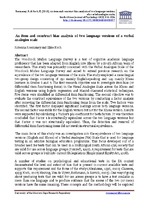| dc.contributor.author | Roomaney, Rizwana | |
| dc.contributor.author | Koch, Elize | |
| dc.date.accessioned | 2017-06-30T09:18:07Z | |
| dc.date.available | 2017-06-30T09:18:07Z | |
| dc.date.issued | 2013 | |
| dc.identifier.citation | Roomaney, R. & Koch, E. (2013). An item and construct bias analysis of two language versions of a verbal analogies scale. South African Journal of Psychology, 43(3): 314–326 | en_US |
| dc.identifier.issn | 0081-2463 | |
| dc.identifier.uri | http://hdl.handle.net/10566/3020 | |
| dc.identifier.uri | http://dx.doi.org/10.1177/0081246313493377 | |
| dc.description.abstract | The Woodcock Muñoz Language Survey is a test of cognitive academic language proficiency that has been adapted from English into Xhosa by a South African team of researchers. This study was primarily concerned with the Verbal Analogies Scale of the Woodcock Muñoz Language Survey and aimed to extend previous research on the equivalence of the two language versions of the scale. The study employed a monolingual two-group design consisting of 150 mainly English-speaking and 149 mainly Xhosa learners in Grades 6 and 7. The first research objective was to investigate item bias (or differential item functioning items) in the Visual Analogies Scale across the Xhosa and English versions using logistic regression and Mantel–Haenszel statistical techniques. Five items were identified as differential item functioning. The second objective was to evaluate the construct equivalence of the two versions by conducting a factor analysis after removing the differential item functioning items from the scale. Two factors were identified. The first factor displayed significant loadings across both language versions. The second factor was stable for the English version but not for the Xhosa version. Results were supported by calculating a Tucker’s phi coefficient for both factors. It was therefore concluded that Factor 1 is structurally equivalent across the two language versions but that Factor 2 was not structurally equivalent. Thus, the detection and removal of differential item functioning items did not result in structural equivalence. | en_US |
| dc.language.iso | en | en_US |
| dc.publisher | SAGE Publications | en_US |
| dc.rights | This is the author-version of the article published online at: http://dx.doi.org/10.1177/0081246313493377 | |
| dc.subject | Bias | en_US |
| dc.subject | Equivalence | en_US |
| dc.subject | Verbal analogies scale | en_US |
| dc.subject | Differential item functioning | en_US |
| dc.subject | Exploratory factor analysis | en_US |
| dc.title | An item and construct bias analysis of two language versions of a verbal analogies scale | en_US |
| dc.type | Article | en_US |
| dc.privacy.showsubmitter | FALSE | |
| dc.status.ispeerreviewed | TRUE | |
| dc.description.accreditation | Department of HE and Training approved list | |

